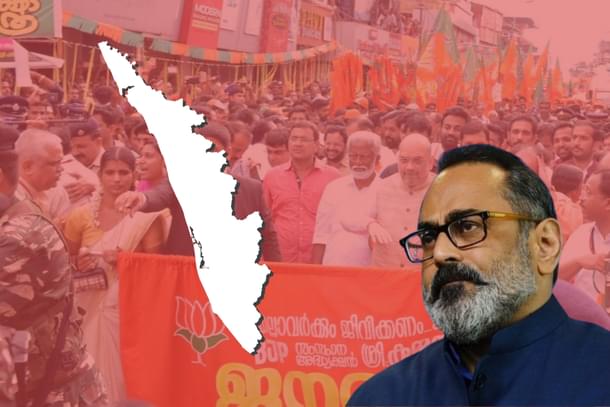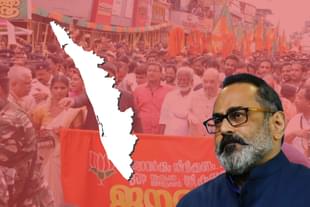States
The Kerala Gamble: Can BJP Grow Without Breaking Something First?
Venu Gopal Narayanan
Jun 02, 2025, 11:44 AM | Updated 11:44 AM IST
Save & read from anywhere!
Bookmark stories for easy access on any device or the Swarajya app.


An early monsoon has brought a welcome lull to things in Parashurama’s Land. It is a good time to review how the Bharatiya Janata Party (BJP) fares in this province. The party faces two electoral challenges in the coming year: local body polls in December, and then the assembly polls next summer.
Last year, the BJP polled 19 per cent in the Lok Sabha elections, along with its partner the Bharath Dharma Jana Sena (BDJS), and won Thrissur parliamentary constituency. The BJP led in 11 of 140 assembly segments, and came a close third in Attingal and Alappuzha seats, both of which saw genuine triangular contests courtesy very spirited campaigns by K Muraleedharan and the feisty Sobha Surendran respectively. This was a major fillip to the party, a severe jolt to the Marxists who won only one seat, and a huge sigh of relief for the Congress-led coalition which swept the balance 19 seats on the back of a strong consolidation of the identity vote under its banner.
To the credit of its workers, the BJP polled more than 40 per cent in six segments, and registered a record 45 percent in Nemom segment. It also polled over 30 per cent in 17 segments; indeed, in Haripad segment, long a fortress of veteran Congress leader Ramesh Chennithala, the BJP’s ally, the BDJS, came within a thousand votes of securing the lead (but bear in mind that this is a BJP seat in assembly elections). And in 15 segments, it polled a solid 25 per cent, upsetting the careful calculations of the other two coalitions.
All in all, it was a moderately decent showing, and a good base for the new state party chief, Rajeev Chandrasekhar, to work with over the coming year.
However, the BDJS has once again failed to pull its weight for the umpteenth time. As before, in multiple assembly segments, it has polled in single digits or the low teens, and even the bulk of that is mainly a reflection of whatever support exists locally for the BJP, and not the BDJS; not even Kayamkulam, where the BDJS candidate polled 33 per cent, on the back of a 26 per cent vote swing from the 2021 assembly elections since, this is actually a reflection of the work done on the ground by the BJP.
The BJP should, therefore, junk this alliance with the BDJS at the soonest for two key reasons: the BDJS brings nothing to the table and, instead, hinders the growth of the BJP. To explain: formed in 2015 as the political wing of the Sree Narayana Dharma Paripalana Yogam (SNDP), a major grouping of the Ezhava Other Backward Caste (OBC) community led by Vellapally Natesan, the BDJS positioned itself as the magnet which would attract the Ezhava vote in droves.
It seemed a smart move at the time since the BDJS was also expected to act as a shield, to insulate the BJP from the threat of political intimidation from the Left (intra-Ezhava violence between the SNDP and the Marxists is a strict no-no in Kerala because it is counterproductive to both sides).
But that did not happen Instead, the Ezhava vote has, thus far, remained steadfastly loyal to the Communist Party of India (Marxist), the CPIM. To make matters worse, the BJP-BDJS alliance has consistently hindered the BJP from making inroads into the Ezhava community, thereby stunting its growth, and still leaving it open to the very real risk of intimidation and violence from the CPIM. This is why the BJP has not been able to expand in any material measure in Kerala.
So, if the BDJS will not bring the Ezhava vote to the ballot box, and will resultantly hinder the BJP from trying to attract the Ezhava vote from the CPIM, then what is the logic of continuing with this alliance?
If the BJP is to grow in Kerala, it will have to do so on its own, at the grassroots level, tackling the inevitable violent backlash from the Marxists exactly as the BJP valiantly did in West Bengal. It is not like the CPIM is going to sit quietly on its hands while the BJP whittles away at its core vote base, creating an existential threat of cataclysmic proportions for the comrades.
In one sense, the situation in Kerala is somewhat similar to that in Maharashtra where the BJP, for the longest time, was prevented from expanding its vote base because of its alliance with the Shiv Sena; and as a result of which, the Maratha vote stayed out of the hands of both. The Maratha analogy doesn’t extend neatly to Kerala because the Marxists have won most of the 14 assembly seats reserved for Scheduled Castes in the past two legislative elections, but the basic point is that a piecemeal supra-caste consolidation is not just a non-starter, but an electorally counterproductive strategy as well.
As of now, a delicate peace holds only because the BJP is still restrained from going after the Ezhava vote in a big way for multiple reasons. This is the political backdrop to Rajeev Chandrasekhar’s recent appointment as BJP state party president, and he has been busy.
Under his predecessor, K Surendran, the BJP instituted an administrative reform, with each district being divided into two organizational districts so as to ensure better links to the wards and booths, and more efficient coordination of activities. Chandrasekhar has, since taking over in late March 2025, already led two rounds of detailed meetings with the heads of the organizational districts, and a strong feedback loop has been established.
Second, he has launched a membership drive. In two short months, an app-based drive to enrol karyakartas has seen numbers quintuple from 19,000 to a lakh.
Third, in advance preparation for the local body polls, appointments have been made for one individual who will be in charge of each gram panchayat, one person in charge of ten urban municipal wards, and one person in charge of five corporation wards.
Fourth, a major re-branding-cum-reorganization has been instituted at three levels – state, organizational district, and ward – with five key office bearers forming “Vikasita Keralam” teams, again, for more efficient functioning, communication, and outreach. The structure of the organization is being strengthened at every level, something which had been long overdue.
However, the party hay yet to appoint an organizational secretary at the state level – a key post. Similarly, many key mid-level posts, the vital links between the state and the ground, are also lying vacant. At one level, this delay in appointment reflects the intense factionalism which has remained the bane of the BJP for years now; at another level, it reflects the wariness of the central leadership, and its calculations, on how much bad blood will erupt depending upon who is appointed to which post.
As a result, while factionalism may seem thankfully to be on the backburner for now, it is actually only that – a hiatus, which will invariably explode into rebelliousness and feuding once these appointments are made. And Chandrasekhar will be limited in the extent to which he can soothe these enraged many because of another problem facing the BJP (a problem which is umbilically linked to pernicious factionalism within): the lack of pan-state leaders who can command the respect of voters and the rank-and-file alike, irrespective of caste, like the late KG Marar once did some decades ago.
But, like the issue of persisting with, or breaking, the alliance with the BDJS, the issue of promoting high calibre leadership is a bullet that will have to be bitten by the BJP sooner rather than later, because there is simply no other way to expand. You need leaders, supported by a robust organizational structure (something which is in the process of being established), prepared to tackle the furious fallout from the CPIM, if you are to expand your party’s electoral base.
No doubt, these are not the only issues faced by the BJP; there are many others, like funding, or tackling the bias of mainstream media. And, it also has to be accepted that these are difficult decisions for a party to make: to what extent can it absorb the internal and external backlash created by its own imperative choices? It is a classic cleft stick situation which the BJP finds itself in: maintain a status quo and stagnate, or force an expansion and run the risk of suffering some serious pain. And yet, for all that, the time to decide is nigh.
Will the BJP do what is direly needed, or not, is the answer to the results of both the forthcoming local body polls, and the assembly elections, in Kerala.
Venu Gopal Narayanan is an independent upstream petroleum consultant who focuses on energy, geopolitics, current affairs and electoral arithmetic. He tweets at @ideorogue.





